
Topics in this Article:
Literature Cited
|
What's up with the name Salvia reflexa and the various incarnations of Salvia lanceolata?
|
|
|
After collecting Salvia reflexa Hornemann, I noticed some odd determinations in SEINet, and some confusion about the correct name for this little, blue North American annual and two other Salvias, one from South Africa and the other from South America, to which some form of S. lanceolata has been applied.
In SEINet,
there are 888 records of Salvia reflexa Hornemann,
and 79 vouchers of collections determined as some form of Salvia lanceolata.
- Eleven are Salvia lanceolata Rydberg
- Two are Salvia lanceolata Lamarck
- and the remaining 66 are Salvia lanceolata Larrañaga.
The eleven vouchers of Salvia lanceolata Rydberg are all at a single local herbarium.
|
|
|
My findings about these names is summarized as follows:
- Salvia reflexa Hornemann is a valid, accepted name for the little blue North American annual Salvia.
- Salvia lanceolata Lamarck is the valid, accepted name for a shrubby, South African Salvia with rust-colored flowers.
The name is occasionally misapplied to S. reflexa Hornemann.
- Salvia lanceolata Broussonet is an unresolved name.
The usually cited publication does not contain the name
and other publication details for this name were not found.
- Salvia lanceolata Larrañaga is an illegitimate name because the name was previously used by Lamarck (1791).
Regardless, it is often used as a synonym for Salvia uliginosa Bentham,
a native of Brazil, Uruguay, and Argentina.
The name is also sometimes misapplied to the North American Salvia reflexa Hornemann.
- Salvia lanceolata Rydberg was never published by Rydberg.
Rydberg (1900, 1906, 1922) used S. lancelolata Willdenow for the little North American annual.
- Salvia lanceolata Willdenow is an illegimate name because the name was previously used by Lamarck (1791).
If it were legitimate, it would now be applied as a synonym
of the North American S. reflexa Hornemann.
The name was widely used as the accepted name by many authors,
such as Bentham (1833), Gray (1878), Britton & Brown (1898), and Rydberg (1900, 1906, 1922),
and cited as a synonym by Harrington (1954).
Weber & Wittmann (2012) and Ackerfield (2015) use S. reflexa Hornemann
and do not list S. lanceolata Willdenow as a synonym.
- Salvia trichostemmoides Pursh is a valid name for a plant collected by the Lewis & Clark expedition and a synonym of Salvia reflexa Hornemann. It should be listed as a synonym in lists of North American locations.
- Salvia aspidophylla Schultes is a valid name for a plant that may have come from Peru, and is likely a good synonym for Salvia reflexa Hornemann. Because it's origin is somewhat unclear, and may have been South American, listing it as a synonym in North American lists seems optional.
|
|
|
Here are some of the details of what I found.
|
|
|
Jean-Baptiste Lamarck
|
|
Literature Cited:
- Lamarck, Jean-Baptiste Pierre Antoine de Monet de, 1791.
- Wikipedia contributors, 2016.
Other articles:
• Glossary:
♄;
|
|
Jean-Baptiste Pierre Antoine de Monet, Chevalier de Lamarck (1 August 1744 – 18 December 1829),
often known simply as Lamarck, was a French naturalist.
He was a soldier, biologist, academic, and an early proponent of the idea that evolution occurred and proceeded in accordance with natural laws.
He gave the term biology a broader meaning by coining the term for special sciences, chemistry, meteorology, geology,
and botany-zoology (Wikipedia, 2016).
|
Lamarck (1791) is apparently the first author to use Salvia lanceolata, applying the name to a shrubby, South African Salvia with rust-colored flowers.
This shrub is available today through the horticultural trade;
though, it is too tender to survive through Colorado winters.
| Original Text
| My Interpretation and Comments
|
322. SALVIA lanceolata
S. foliis lanceolatis integerrimis breviffime tomentofis,
calycibus obtufis corollarum tubo brevioribus.
E Capitae Bonæ Spei. ♄ Sonnerat.
|
322. SALVIA lanceolata
S. leaf lanceolate entire very short tomentose,
calyx obtuse[,] corolla tube short.
From Cape of Good Hope. Shrub. Sonnerat. [Collector was Pierre Sonnerat.]
|
|
|
|
Jens Wilken Hornemann
|
|
Literature Cited:
- Hornemann, Jens Wilken, 1804.
- Wikipedia contributors, 2016a.
|
|
Jens Wilken Hornemann (6 March 1770 – 30 July 1841) was a Danish botanist.
He was a lecturer at the University of Copenhagen Botanical Garden from 1801.
After the death of Martin Vahl in 1804, the task of publishing the Flora Danica was given to Hornemann,
who subsequently issued fasc. 22-39 (1801–1840) with a total of 1080 plates.
J.W. Hornemann was professor of botany at the University of Copenhagen from 1808 and director of the Botanic Garden (from 1817).
In 1815, he was elected a corresponding member of the Royal Swedish Academy of Sciences,
and in 1816, his status was changed to that of foreign member (Wikipedia, 2016).
|
Hornemann's (1804) Enumeratio plantarum horti botanici Hafniensis,
a list of the plants at the Copenhagen botanical gardens, is not available online.
“Hafnia” is a Latin geographical name for Copenhagen.
WorldCat reports the only copy available is at the State Library of Berlin.
|
|
Literature Cited:
- Earle, A. Scott, and James L. Reveal, 2003.
- Hornemann, Jens Wilken, 1807.
|
It appears that the second edition of Hornemann's Enumeration contains the description of Salvia reflexa Hornemann.
|
Hornemann based his 1806 description on a garden specimen —
introduced into Europe from Mexico — giving it the scientific name that we know it by today (Earle & Reveal, , p. 46)
|
|
|
|
Augustus Broussonet
|
|
|
Pierre Marie Auguste Broussonet (28 February 1761 – 17 January 1807), French naturalist, was born at Montpellier.
|
|
Literature Cited:
- Broussonet, Augustus, 1805.
|
Broussonet's (1805) Elenchus plantarum horti botanici Monspeliensis is a listing of plants found at the Montpellier Botanic Garden.
Broussonet was Director of the garden from 1803 until his death in 1806.
Curiously, the list does not contain Salvia lanceolata
as might be expected from Willdenow's description below.
This would seem to remove Broussonet from contention as an author of the name S. lanceolata.
|
|
|
Carl Ludwig Willdenow
|
|
Literature Cited:
- Wikipedia contributors, 2016b.
- Willdenow, Carl Ludwig, 1809.
Other articles:
• Glossary:
☉;
|
|
Carl Ludwig Willdenow (22 August 1765 – 10 July 1812) was a German botanist, pharmacist, and plant taxonomist.
He is considered one of the founders of phytogeography, the study of the geographic distribution of plants.
Willdenow was also a mentor of Alexander von Humboldt, one of the earliest and best known phytogeographers.
He was a director of the Botanical garden of Berlin from 1801 until his death (Wikipedia, 2016).
|
Willdenow's (1809, p. 37) description of Salvia lanceolata from his Enumeratio Plantarum Horti Regii Botanici Berolinensis, a listing of plants in the regional botanic gardens of Berlin.
Willdenow seems to be unaware of Lamarck's (1791) use of the name S. lanceolata
or, perhaps, it simply was not grown in the Berlin garden.
* 18. SALVIA lanceolata.
S. foliis lanceolatis obtusis remote serratis subtus pubescentibus petiolatis,
spica racemosa alari, verticillis bifloris,
bracteis lanceolatis pedunculum subaequantibus.
Salvia lanceolata Broussonet.
S. (reflexa) incana, foliis lanceolatis obtusis crenatis,
recemis elongatis ex dichotomia ramonum.
Hornem. Enum pl. hort. Haf. 34.
Habitat . . . . . . . . ☉. D.
|
|
Caulis pedalis et altior erectus ramosus tatragonus pubescens.
Folia pollicaria et ultra, angusto-linearia obtusa,
basi in petiolum angustata, remote obtuse werrata, supra glabra,
subtus pubescentia.
Spica racemosa quadri-vel quinquepollicaris alaris,
id est e dichotomia caulis orta.
Flores oppositi pedunculati, ita ut verticilli tantum biflori remotissimi.
Pedunculi calyce parum breviores.
Bracteae angusto-lanceolatae longitudine pedunculi vel parum longiores.
Calyces campanulati bilabiati, labium superius ovatum acutum, inferius bifidum.
Corolla praecedentis, sed labium superius emarginatum.
Accedit habitu ad praecedentem, sed characteribus indicatis abunde diversa.
|
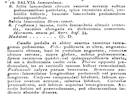
Willdenow's description of Salvia lanceolata |
|
|
|
Damaso Antonio Larrañaga
|
|
Literature Cited:
- Wikipedia contributors, 2016c.
|
|
Dámaso Antonio Larrañaga (Montevideo, 10 December 1771 – 6 February 1848) was a Uruguayan priest, naturalist and botanist.
He was one of those principally responsible for the founding of the National Library of Uruguay and the National University of Uruguay
(Wikipedia, 2016).
|
|
|
Literature Cited:
- Larrañaga, Dámaso Antonio, 1922.
- Larrañaga, Dámaso Antonio, 1923.
|
Salvia lanceolata Larrañaga was described in Part 2, page 12 of Larrañaga's “Writings.”
While the writing occurred sometime in the late 1810's, they were not published until 1923.
Part 1 of Larrañaga's writings are available through Biodiversity Heritage Library.
I have not found an online source for Part 2.
Regardless, Larrañaga's use of the name was illegitimate, because it was previously published by Lamarck (1791).
In the meantime, Bentham (1833) published his Salvia uliginosa Bentham,
for which some sources treat Salvia lanceolata Larrañaga a synonym,
despite its illegitimacy.
|
|
|
Frederick Pursh
|
|
Literature Cited:
- Earle, A. Scott, and James L. Reveal, 2003.
- Moulton, Gary E., 1999.
|
Lewis made two collections of a mint on September 21, 1804 at the Big Bend of the Missouri River in Lyman County, South Dakota.
|
When Frederich Pursh examined Lewis's plant, he saw that it was a Salvia and named it Salvia trichostemmoides
(his species name means “similar to Trichostema,” a genus of North American herbs and shrubs).
Pursh did not recognize the plant as one already described by Jens Wilken Hornemann (1770-1841),
a physician and professor of botany at Copenhagen (Earle & Revel, 2003).
|
|
|
Literature Cited:
- Pursh, Frederick, 1814.
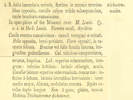 Pursh's (1814) description of Salvia trichostemmoides. Pursh's (1814) description of Salvia trichostemmoides.
|
| Original Text
| Interpretation and Comments
|
|
3. S. foliis lanceolatis serratis,
floribus in racemis terminalibus oppositis,
corollis calyce trifido subæquantibus,
caule brachiato-ramosissimo.
|
trichostem-
moides
|
|
|
|
In open plains of the Missouri river.
M. Lewis. ☉.
v. s. in Herb. Lewis.
Flowers small, sky-blue.
|
|
|
|
Caulis erectus ramosissimus: ramuli tetragoni 4-sulcati.
Folia opposita, brevi-petiolata.
Flores oppositi, in racemis foliosis.
Bracteæ vel folia floralia lineares, longitudine pedicellorum.
Cal. tubuloso-campanulatus, striatus, hispidus.
Lab. superius subrotundum, integrum: inferius 2-fidum: laciniis oblongis, acutis.
Corollæ labium superius subrotundum, concavum: inferius 3-lobum, laciniis lateralibus brevissimis:
intermedia major, dilatata, undulatim-crenata.
Stylus corollæ duplo longior.
Sem. 3-gona, glabra, venosa.
Habitus Trichostemmæ dichotomæ.
|
|
|
|
|
|
Josef August Schultes
|
|
Literature Cited:
- Wikipedia contributors, 2016d.
|
|
Josef (Joseph) August Schultes (15 April 1773 in Vienna – 21 April 1831 in Landshut) was an Austrian botanist and professor from Vienna.
Together with Johann Jacob Roemer (1763–1819), he published the 16th edition of Linnaeus' Systema Vegetabilium.
In 1821, he was elected a foreign member of the Royal Swedish Academy of Sciences.
He was the father of Julius Hermann Schultes (1804-1840).
|
|
In 1796 he received his doctorate at Vienna, where he was a student of Johann Peter Frank (1745-1821).
Later on, he served as a professor of botany and natural history at the Theresianum in Vienna,
followed by professorships at the Universities of Krakow (1806) and Innsbruck (1808).
In 1809 he succeeded Franz von Paula Schrank (1747-1835) at the University of Landshut as a professor of natural history and botany.
At Landshut, he also served as a medical director.
Swedish botanist Carl Peter Thunberg commissioned Schultes to edit the first complete edition of his Flora Capensis,
which was published in 1823.
|
|
|
Literature Cited:
- Schultes, Josef A., 1822.
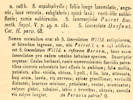 Schultes (1822) description of Salvia aspidophylla. Schultes (1822) description of Salvia aspidophylla.
|
Schultes' (1822) description of his Salvia aspidophylla was of a plant Shultes thought was possibly from Peru.
The Greek root aspido- implies that the leaves are shield-shaped.
|
n. 108b. S. aspidophylla; foliis longe lanceolatis, angustis, laxe serratis, subglabris, spicâ laxâ;
verticillis subfloris; ramis subhirsutis.
S. lanceaefolia Poiret Enc. meth. Suppl. V. p. 49. n. 151.
S. lanceolata Desfont. Cat. H. paris. 68.
|
|
Nomen mutandum erat ob S. lanceolatum Willd. antiquiorem, et fatendum ingenue, nos,
nisi Poiret l. c. n. 143 adduxisset S. lanceolatum Willd. s. reflexam Hornem.,
hanc suam lanceolatam pro eadem omnio habuisse speciem.
Descriptio sequens:
Caules herbacei, ramis numerosissimis flaccidis patentibus cinereis subscabris basi effusis in ambitum;
folia mollia, petiolata, albo-virida, obtusa, 3 poll., 6 lin. lata, attenuata, basi acuta, laevia, vix nervosa;
spicae gracillimae; verticilli distantes;
bracteae minimae, petiolatae, ovate, acuminatae;
calyces glabri, tubulosi, labiis 2 brevibus, obtusis; corolla vix calyce longior.
An Peruvia patria?. ☉
|
|
|
|
George Bentham
|
|
Literature Cited:
- Bentham, George, 1833.
 Bentham's (1833) description of Salvia nivea Bentham's (1833) description of Salvia nivea
|
Bentham, lists Thunberg's Salvia nivea, and gives S. lanceolata Lamarck as a synonym. However, Thunberg published his name in 1800, so it would appear that Lamrack's (1791) name would have priority.
25. S. nivea (Thunb. Prodr. Fl. Cap. 96).
S. lanceolata. Lam. Ill. 1. 72. sec. Vahl.
Hab. ad Caput Bonæ Spei Thunberg.
|
|
“S. foliis lanceolatis integerrimis albo-tomentosis, ramis divaricatis.” — Thunb. l. c.
|
|
“Caulis erectus, 3-pedalis.
Rami et ramuli decussati, tetragoni, sulcati, inferne glabri, superne tomentosi.
Folia opposita, petiolata, acuta, parum rugosa, convoluta, nivea, patula, internodiis breviora, pollicaria.
Flores oppositi vel subpaniculati in apicibus ramulorum.
Calyces hirti.
Corollæ purpureæ, calyce duplo longiores.
Similis S. aureæ et chamæeleagneæ, sed distinguitur facile foliis lanceolatis niveis.”
— Thunb. Fl. Cap. MSS. ex Rœm. et Schult. Syst. Mant. 1.
|
|
|
Literature Cited:
- Bentham, George, 1833.
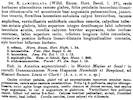 Bentham's (1833) description of Salvia lanceolata Bentham's (1833) description of Salvia lanceolata
|
Bentham's (1833) Labiatarum Genera et Species, description of S. lanceolata.
|
94. S. lanceolata (Willd. Enum. Hort. Berol. 1. 37),
caule herbaceo adscendente ramoso glabro,
foliis petiolatis lanceolato-linearibus obtusiusculis vel acuminatis basi angustatus pubescentibus,
junioribus incanis, floralibus lanceolato-subulatis calyce brevioribus,
racemis simlicibus, verticillastris subifloris omnibus remotis,
calycibus tubulosis striatus glabris, labio superiore integro dentibusque labii inferioris lanceolatis acutis,
corollis calycem breviter superante, tubo incluso ventricoso, labio superiore recto,
inferiore longiore lobis rotundatis,
connectivis postice deflexis lineari-dilatatis longitudinaliter connatis,
stylo breviter bifariam barbato.
|
S. reflexa. Horn. Enum. Hort. Hafn. 1. 34.
S. lanceaefolia. Poir. Dict. Suppl. 5. 49.
S. lanceolata. Jacq. Fil. Ecl. 1. 13. t. 13.
S. aspidophylla. Roem. et Schult. Syst. Mant. 1. 206.
S. trichostemmoides. Pursh! Fl. Am. Sept. 1. 19.
|
|
Hab. in America septentrionali: in Mexico Mocino et Sesse!
in convalli Guanaxuatense Novae Hispaniae Humboldt et Bonpland,
ad Missouri flumen Lewis et Clark! (h. s. c. et v. s. sp.)
|
|
Caules circiter pedales, glabri vel ad extremitatem ramorum tenuiter canopubescentes,
ramis saepe racemos excedentibus.
Folia 1½-2-pollicaria, saepius oblongolinearia, nunc apice longe angustata,
medio obscure et obtuse serrata, basi saepius longe angustata, in var. ß angustiora et glabriora.
Verticillastri fere pollicem remoti, biflori vel rarius 2-4 flori.
Calyces breviter pedicellati, striati, fructiferi valde aucti, basi inflati.
Corolla coerulea, (cum calyce) vix 4-linearis.
|
|
|
Literature Cited:
- Bentham, George, 1833.
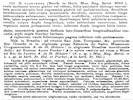 Bentham's (1833) description of Salvia uliginosa Bentham's (1833) description of Salvia uliginosa
|
Salvia uliginosa Benth., syn: S. lanceolata Larrañaga
|
101. S. uliginosa (Benth. in Mus. Reg. Berol. MSS.),
caule herbaceo erecto glabro vel villoso,
foliis periolatis oblongo-lanceolatis acutis serratis basi angustatis glabris vel pubescentibus,
floralibus membranaceis lato-ovatis acuminatis deciduis,
racemis densis longe pedunculatis subramosis, verticillastris multifloris,
calycibus campanulatis,
labio superior subintegro dentibusque labii inferioris acuminatis,
corollis calyce duplo longioribus, tubo subincluso ventricoso,
labio superior extus pubescente recto,
inferiore duplo longiore lobis rotundatis,
connectivis postice deflexis lato-linearibus longitudunaliter connatis,
stylo supra supra breviter barbato.
|
|
ß rufescens, caule foliorumque pagina inferiore rufo-pubescente,
|
|
Hab. in Brasilia: ad rivulos San Jose, Toropassa, &c. provinciae Rio Grande et in ulignosis prope Estancia
do Salto Missionum Uruguaiensium A. de St. Hillaire!
in uliginosis Brasilias meridionalis Sello!
ad Buenos Ayres Parker!
ß in sylvia caeguis ad viam a Minas ad Rio de Janiero A. de St. Hillaire!
(h. s. sp. e Mus. Reg. Berol. et v. s. sp. in herb. St. Hil. et Parker, ß in herb. St. Hil.)
|
|
Caules 2-6-pedales, virgati, ramosi, obtuse tetragoni, sulcati, glandulosi, glabriusculi vel pilis articulatis villosi.
Petiole breves.
Folia 2-4-pollicaria, forma variabilia, nunc vix 3-4 lin. lata basi longe angustata,
nunc fere pollicem lata basi cineata vel rarius rotundata, saepius profunde serrata,
viridia, membranacea, subtus nervosa, glaberrima vel utrinque pubescentia,
subtus uti calyces glandulis nigris crebris punctata, floralia membranacea, flavescentia,
longe acuminata, ante anthesin saepius comosa, rarius fere abortiva, per anthesin decidua.
Racemi 1-4 spicaeformes, pedunculati, a foliis caulinis longe distantes.
Calyces subsessiles, glabri vel cano-pubescentes, striati vel laeves, incani,
colorati vel virides, dentibus lato-ovatis vel ovato-lanceolatis, superiore integro 1-3-mucronato,
inferiore plus minusve cuspidato,
Corolla coerulea vel alba, magnitudine corollae S. polystachydis.
Connectiva sub insertione calloso-dentata.
Stylus subexsertus, lobis subulatis, superiore duplo longiore.
|
|
Species more plantarum uliginosarum valde variabilis, sed vix dividenda.
|
|
|
|
Per Axel Rydberg
|
|
Literature Cited:
- Rydberg, Per Axel, 1900a.
|
Rydberg's (1900) Catalogue of the Flora of Montana and Yellowstone National Park contains the following entry for Salvia lanceolata:
Salvia lanceolata Willd. Enum. 37 [Ill. Fl. 3:100; Syn. Fl. 21: 369; Man. R. M. 296].
On dry prairies, up to an altitude of 2000 m.
Montana: Helena, 1889. Kelsey.
|
In the preface, Rydberg explains:
“Man. R. M.,” Coulter, Manual of the Rocky Mountain Region.
“Ill. Fl.,” Britton & Brown, Illustrated Flora.
“Syn. Fl.,” A. Gray, Synoptical Flora.
|
|
|
Literature Cited:
- Rydberg, Per Axel, 1906.
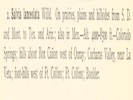 Rydberg's (1906) use of the name Salvia lanceolata Rydberg's (1906) use of the name Salvia lanceolata
|
Rydberg's (1906) Flora of Colorado attributes the name Salvia lanceolata to Willdenow.
|
2. Salvia lanceolata Willd. On prairies, plains and hillsides from S. D. and Mont. to Tex. and Ariz.;
also in Mex. — Alt. 4000–8500 ft. — Colorado Springs;
hills about Box Cañon west of Ouray; Cucharas Valley, near La Veta; foot-hills west of Ft. Collins;
Ft. Collins; Boulder.
|
|
|
Literature Cited:
- Rydberg, Per Axel, 1922.
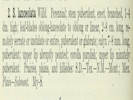 Rydberg's (1922) use of the name Salvia lanceolata Rydberg's (1922) use of the name Salvia lanceolata
|
Rydberg's (1922) edition of the Flora of the Rocky Mountains and Adjacent Plains uses the Salvia lanceolata name and attributes it to Willdenow.
|
2. S. lanceolata Willd. Perennial; stem puberulent, erect, branched, 1-4 dm. high;
leaf-blades oblong-lanceolate to oblong or linear, 2-8 cm. long, puberulent; upper lip abruptly pointed;
corolla purplish; upper lip minutely puberulent.
Prairies, plains, and hillsides: S.D. — Tex. — N.M. — Mont.; Mex.
Plain — Submont. My – S.
|
|
|
|
Harold D. Harrington
|
|
Literature Cited:
- Harrington, H. D., 1954.
|
Harrington (1954) is the last Colorado-oriented manual to show the synonomy of Salvia lanceolata to Salvia reflexa.
1. Salvia reflexa Hornem., Enum. Pl. Hort. Hafn. 1:34. 1807.
Salvia lanceolata of Manuals---Plants annual; stems 10-30 cm. tall, puberulent to nearly glabrous,
branched from base; leaves 2-6 cm. long, oblong-lanceolate to oblong, sometimes as narrow as linear,
entire to undulate or remotely serrate; calyx 4-8 mm. long, enlarging some in fruit;
corolla tube included in the calyx, the whole corolla 8-12 mm. long, light purple or whitish tinged with blue.
---Prairies, plains, fields and roadsides. Wisconsin to Wyoming, south to Illinois, Texas, Arizona and Mexico.
Our records scattered over Colorado, except the northwestern part, at 3500-8000 feet.
|
|
|
|
Tiehm and Stafleu, 1990
|
|
Literature Cited:
- Tiehm, Arnold, and Frans A. Stafleu, 1990.
|
The chapter, “New Taxa Described by Per Axel Rydberg” in Tiehm & Stafleu (1990) does not include a Salvia lanceolata that was published by Rydberg, indeed contains no Salvias at all.
|
|
|
Reveal, Moulton & Schuyler, 1999
|
|
Literature Cited:
- Reveal, James L., Gary E. Moulton and Alfred E. Schuyler, 1999.
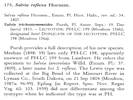 Reveal, Moulton and Schuyler (1999) on Salvia reflexa. Reveal, Moulton and Schuyler (1999) on Salvia reflexa.
|
|
173. Salvia reflexa Hornem.
|
Salvia reflexa Hornem., Enum. Pl. Hort. Hafn., rev. ed.: 34. 1807.
Salvia trichostemmoides Pursh, Fl. Amer. Sept.: 19. Dec (sero) 1813.
- LECTOTYPE: PH-LC 199 (Moulton 156b), designated here! DUPLICATE OF THE LECTOTYPE: PH-LC 198 (Moulton 156a).
|
|
Pursh provides a full description of his new species.
Meehan (1898: 39) lists only PH-LC 198, apparently unaware of PH-LC 199 from Lambert.
He refers the specimen to Salvia lanceolata Willd. (Enum. Pl.: 37. 1809), a later name for S. reflexa.
The Lewis type was collected at the Big Bend of the Missouri River in Lyman Co., South Dakota,
on 21 Sep 1804 (Moulton, 1987a: 96-99).
Epling (in Repert. Spec. Nov. Regni Veg. 60: 103. 1939) did not differentiate
among the syntypes when he indicated the type was at PH.
|
|
|
Literature Cited:
- Weber, William A., and Ronald C. Wittmann, 2012.
|
Weber & Wittman (2012) list S. reflexa Hornemann, without synonomy, and note that it is an “ … Alien, weedy annual on floodplains, uncommon.”
|
|
Literature Cited:
- Ackerfield, Jennifer, 2015.
|
Ackerfield (2015) lists Salvia reflexa Hornem. with a common name of “Rocky Mountain Sage.&rdquo.
No mention is made of the plant being introduced, thereby suggesting that it may be native.
|
|
|
Recommended Changes to Taxon Tree
- Lamiaceae
- Salvia L.
- Salvia lanceolata Lamarck — add this accepted name to forestall adding other illegitimate uses of the name.
Salvia lanceolata Larrañaga — move to S. uliginosa where it is properly a synonym.
- Salvia reflexa Hornem.
- [Salvia lancifolia Poir.]
- [Salvia trichostemmoides Pursh] — add synonym as written by Pursh and preserved by others, such as Reveal, Schuyler & Moulton (1999).
- [Salvia trichostemoides Pursh [orth. var.]] — add author and note orthographic variation.
- [Salvia lanceolata Rydb. [unpub.]] — add this name for completeness, because it has been used as a name for this taxon.
- [Salvia lanceolata Willd. [illeg.]] — add this name for completeness, because it was previously commonly used as a name for this taxon.
- Salvia uliginosa Benth.
- [Salvia lanceolata Larrañaga [illeg.]] — while illegitimate, need to keep this in the taxon tree because some collections use this name.
|
|
|
Literature Cited
A list of all literature cited by this web site can be found in the Bibliography.
|
| |
Ackerfield, Jennifer. 2015.
Flora of Colorado.
Fort Worth, TX 76107-3400: Botanical Research Institute of Texas, 2015.
|
| |
Bentham, George. 1833.
Labiatarum Genera et Species.
{TAS-pdf}
|
| |
Broussonet, Augustus. 1805.
Elenchus plantarum horti botanici Monspeliensis.
Link to external document.
Date retrieved: 30 September 2016, 12 January 2021.
|
| |
Earle, A. Scott, and James L. Reveal. 2003.
Lewis and Clark's Green World: The Expedition and its Plants.
Helena, Montana: Farcountry Press, 2003.
|
| |
Harrington, H. D. 1954.
Manual of the plants of Colorado.
Denver, CO.: Sage Books., 1954.
|
| |
Hornemann, Jens Wilken. 1804.
Enumeratio Plantarum Horti Botanici Hafniensis. Havniae [Kjöbenhavn].
|
| |
Hornemann, Jens Wilken. 1807.
Enumeratio Plantarum Horti Botanici Hafniensis. Havniae [Kjöbenhavn], 2nd Edition.
|
| |
Lamarck, Jean-Baptiste Pierre Antoine de Monet de. 1791.
Tableau encyclopédique et méthodique des trois re`gnes de la nature. Botanique.
(Source: http://www.biodiversitylibrary.org/item/6086, date retrieved: 2 October 2016).
|
| |
Larrañaga, Dámaso Antonio. 1922.
Escritos de don Dámaso Antonio Larrañaga.
Part I.
Montevideo, Uruguay: Instituto Historico y Geografico del Uruguay, 1922.
|
| |
Moulton, Gary E. 1999.
Herbarium of the Lewis & Clark Expedition.
The Journals of the Lewis & Clark Expedition.
12.
1999.
|
| |
Pursh, Frederick. 1814.
Flora Americae Septentrionalis; or, A Systematic Arrangement and Description of the Plants of North America.
1.
London: White, Cochrane, and Co., 1814.
Link to external document.
Date retrieved: 24 February 2016. biodiversitylibrary.org/item/1987
|
| |
Reveal, James L., Gary E. Moulton and Alfred E. Schuyler. 1999.
The Lewis and Clark Collections of Vascular Plants: Names, Types, and Comments.
Proceedings of the Academy of Natural Sciences of Philadelphia.
149: 1-64.
{TAS-pdf}
Stable URL: http://www.jstor.org/stable/4065037, accessed 13 September 2014.
|
| |
Rydberg, Per Axel. 1900a.
Catalogue of the Flora of Montana and Yellowstone National Park.
Memoirs of the New York Botanical Garden.
1.
Link to external document.
Preface dated February 15, 1900.
|
| |
Rydberg, Per Axel. 1906.
Flora of Colorado.
Bulletin 100.
Fort Collins, Colorado: Experiment Station, Colorado Agricultural College, 1906.
Link to external document.
Date retrieved: 30 September 2016. DOI: http://dx.doi.org/10.5962/bhl.title.2486
|
| |
Rydberg, Per Axel. 1922.
Flora of the Rocky Mountains and Adjacent Plains.
2nd edition.
New York: 1922.
|
| |
Schultes, Josef A. 1822.
Mantissa in Volumen Primum Systematis Vegetabilium Caroli A Linne.
|
| |
Tiehm, Arnold, and Frans A. Stafleu. 1990.
Per Axel Rydberg: A Biography, Bibliography and List of His Taxa.
Memoirs of the New York Botanical Garden.
58.
Bronx, New York: New York Botanical Garden, 13 March 1990.
{TAS}
|
| |
Weber, William A., and Ronald C. Wittmann. 2012.
Colorado Flora: Eastern Slope.
4th Edition.
Boulder, Colorado: University Press of Colorado, 2012.
{TAS}
|
| |
Wikipedia contributors. 2016.
Jean-Baptiste Lamarck.
Wikipedia, The Free Encyclopedia.
(Retrieved: 4 October 2016. https://en.wikipedia.org/w/index.php?title=Jean-Baptiste_Lamarck&oldid=741194188. )
|
| |
Wikipedia contributors. 2016a.
Jens Wilken Hornemann.
Wikipedia, The Free Encyclopedia.
(Retrieved: 4 October 2016. https://en.wikipedia.org/w/index.php?title=Jens_Wilken_Hornemann&oldid=719147767.)
|
| |
Wikipedia contributors. 2016b.
Carl Ludwig Willdenow.
Wikipedia, The Free Encyclopedia.
(Retrieved: 4 October 2016. https://en.wikipedia.org/w/index.php?title=Carl_Ludwig_Willdenow&oldid=727606080.)
|
| |
Wikipedia contributors. 2016c.
Dámaso Antonio Larrañaga.
Wikipedia, The Free Encyclopedia.
(Retrieved: 4 October 2016. https://en.wikipedia.org/w/index.php?title=D%C3%A1maso_Antonio_Larra%C3%B1aga&oldid=741658152.)
|
| |
Wikipedia contributors. 2016d.
Josef August Schultes.
Wikipedia, The Free Encyclopedia.
(Date retrieved: 6 October 2016. https://en.wikipedia.org/w/index.php?title=Josef_August_Schultes&oldid=715505515.)
|
| |
Willdenow, Carl Ludwig. 1809.
Enumeratio Plantarum Horti Regii Botanici Berolinensis.
Part I.
Berlin: 1809.
(Retrieved: 1 October 2016, http://bibdigital.rjb.csic.es/ing/Libro.php?Libro=1684)
|
|
If you have a question or a comment you may write to me at:
tomas@schweich.com
I sometimes post interesting questions in my FAQ, but I never disclose your full name or address.
|
[Home Page] [Site Map]
Date and time this article was prepared:
5/12/2025 2:41:08 PM
|
 Eastern Mojave Vegetation
Eastern Mojave Vegetation
 Eastern Mojave Vegetation
Eastern Mojave Vegetation
